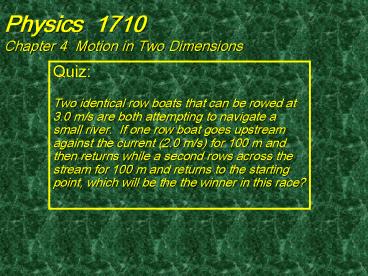Physics 1710 Chapter 4 Motion in Two Dimensions - PowerPoint PPT Presentation
1 / 19
Title:
Physics 1710 Chapter 4 Motion in Two Dimensions
Description:
Two identical row boats that can be rowed at 3.0 m/s are both attempting to ... If one row boat goes upstream against the ... Projectiles follow a parabola. ... – PowerPoint PPT presentation
Number of Views:84
Avg rating:3.0/5.0
Title: Physics 1710 Chapter 4 Motion in Two Dimensions
1
Physics 1710Chapter 4 Motion in Two Dimensions
- Quiz
- Two identical row boats that can be rowed at 3.0
m/s are both attempting to navigate a small
river. If one row boat goes upstream against the
current (2.0 m/s) for 100 m and then returns
while a second rows across the stream for 100 m
and returns to the starting point, which will be
the the winner in this race?
2
Physics 1710Chapter 4 Motion in Two Dimensions
t1 d/ (vo V ) d/ (vo V)
2
t1 100/ (3-2) 100/ (32) 120 sec
V
t2 2d/ (vvo2 V 2 )
t2 2(100)/ (v32 22 ) 200/ (v5 )
89.4 sec
v vvo2 V 2
1
3
Physics 1710Chapter 4 Motion in Two Dimensions
- 1 Lesson
- Displacement, velocity and acceleration are
vector quantities in two or more dimensions. - Each component of the kinematic variables
- is separate and independent.
- In projectile motion the x-motion is
unaccelerated while the y-motion experiences a
constant acceleration equal to g. - Uniform circular motion requires an
ever-changing acceleration of constant magnitude. - Relative motion obeys the Galilean
Transformation.
4
Physics 1710Chapter 4 Motion in Two Dimensions
- Position r is a vector.
- r x i y j
- Or rx x ry y
- Thus, one can represent a vector by a position
vector, ie an arrow.
5
Physics 1710Chapter 4 Motion in Two Dimensions
- Displacement in 2-D is a vector
- ? r r final - r initial
- ? rx x final - x initial ?x
- ? ry yfinal - y initial ?y
- ? r ?? r?
- ?? r? v(x final - x initial ) 2 (yfinal - y
initial) 2 - Tan ? (yfinal - y initial)/ (x final - x
initial )
6
Physics 1710Chapter 4 Motion in Two Dimensions
- Average velocity is a vector
- vave ? r / ?t
- This means the following
- vx, ave ? x / ?t
- vy, ave ? y / ?t .
7
Physics 1710Chapter 4 Motion in Two Dimensions
- Instantaneous velocity is a vector
- v lim ?t ? 0 ? r / ?t
- This means the following
- vx lim ?t ? 0 ? x / ?t dx /dt
- vy lim ?t ? 0 ? y / ?t dy/dt
8
Physics 1710Chapter 4 Motion in Two Dimensions
- Average acceleration is a vector
- aave ? v / ?t
- This means the following
- ax, ave ?vx / ?t
- ay, ave ?vy / ?t .
9
Physics 1710Chapter 4 Motion in Two Dimensions
- Instantaneous acceleration is a vector
- a lim ?t ? 0 ? v / ?t
- This means the following
- ax lim ?t ? 0 ? vx / ?t dvx /dt
- ay lim ?t ? 0 ? vy / ?t dvy /dt
- N.B.
- The components are strictly segregated!
10
Physics 1710Chapter 4 Motion in Two Dimensions
- Motion in Two Dimensions
- All the one dimensional kinematic equations can
be generalized to two (or more) dimensions. - All the component equations obey the one
dimensional kinematics separately.
11
Physics 1710Chapter 4 Motion in Two Dimensions
- Vector kinematic equations (uniform a)
- rfinal rinitial vinitial t ½ a t 2
- vfinal vinitial a t
12
Physics 1710Chapter 4 Motion in Two Dimensions
- Projectile Motion
- Horizontal acceleration
- ax 0
- ? vx, final vx, initial
- xfinal x initial vx, initial t .
- Vertical acceleration
- ay -g
- ? vy, final vy, initial - g t
- yfinal y initial vy, initial t - ½ g t 2
13
Physics 1710Chapter 4 Motion in Two Dimensions
- Parabolic Motion
14
Physics 1710Chapter 4 Motion in Two Dimensions
- Uniform Circular Motion
- ?a? a,
- a constant value always pointing toward the
center of the circle. Centripedal acceleration. - a ax i a y j,
- where
- ax a cos ?
- ay a sin ?
15
Physics 1710Chapter 4 Motion in Two Dimensions
- Uniform Circular Motion
- a v 2 /R,
- The Centripedal acceleration, where v is the
tangential speed and R is the radius of the
circle. - v 2pR / T ,
- Where T is the period or time to make one
revolution. - a 4p 2R/ T 2
16
Physics 1710Chapter 4 Motion in Two Dimensions
- Uniform Circular Motion
Rd ?/ dt vd ? dv dt/v Rd(dv/v)/ dt 2
vd2v/dt 2 v 2 /R
d ?
R
v
d ?
dv dt
v
17
Physics 1710Chapter 4 Motion in Two Dimensions
- Uniform Circular Motion
g
a
a
g
18
Physics 1710Chapter 4 Motion in Two Dimensions
- Relative Motion
- and the Galilean Transformation
- d r '/dt d r/dt - vo
- v ' v vo
- d v '/dt d v/dt d vo/dt
- a ' a ao
19
Physics 1710Chapter 4 Motion in Two Dimensions
- Summary
- Kinematics in two (or more) dimensions obeys the
same 1- D equations in each component
independently. - Projectiles follow a parabola.
- Uniform circular motion has an acceleration
toward the center of a circle that is constant in
magnitude a v 2/R. - Frames of reference moving relative to each
other obey the Galilean transformation.































